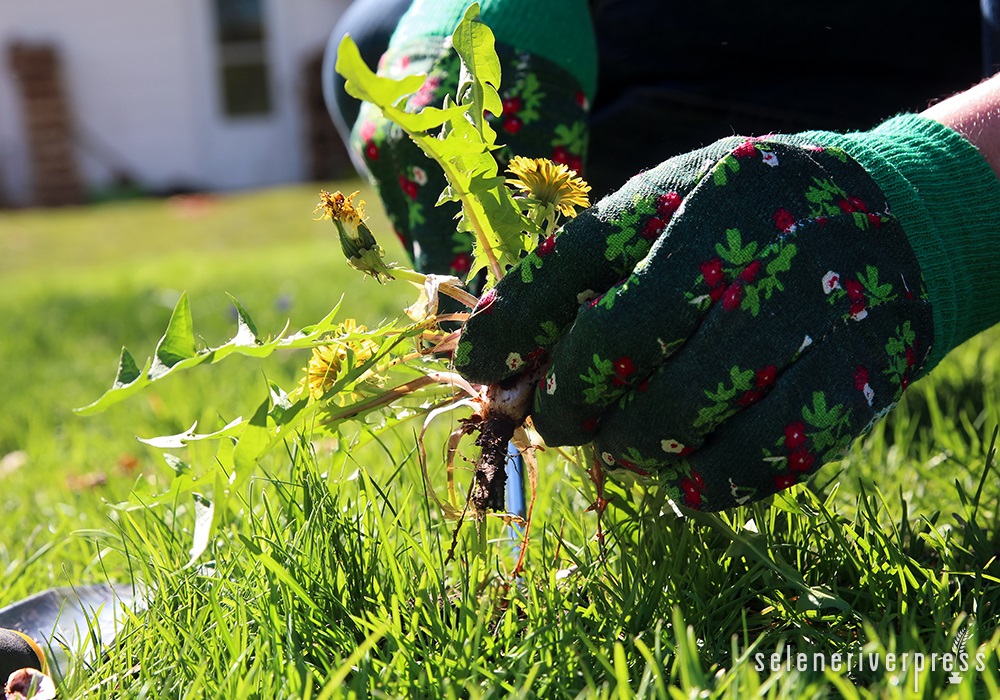Are you one of those eccentric people who’ve earned the title of “health nut” or some other such name that puts you outside of the mainstream?
If you are, your eating choices probably include whole grains, grass-fed beef, and pastured eggs. And if you’re a true health nut, I guarantee that at some point in time you’ll also be driven to eat weeds! Yes, I know, that may sound a little off the beaten path, but weeds are truly worth growing, cooking, and using in your next salad.
Below is a quote from Tina Sams, one of my favorite authors and the editor of The Essential Herbal. I completely agree with her, which is why I urge you to join me as I tell you about edible weeds and why you should consider including these wonders of Mother Nature into your daily meals.
“We’ve all gotten so comfortable with the idea of ‘hunting and gathering’ our sustenance in a forest of plastic and Styrofoam containers. We struggle to clear our lawns and gardens of the very plants that our ancestors brought with them from faraway lands, and tended carefully in their gardens. In fact, many of the weeds that are considered wild foods escaped those long-ago gardens and continue to grow in the wilds.”
—Tina Sams
I found this quote in Tina’s ebook Wild Foods for Every Table. Personal note: I highly recommend this ebook as it has the best collection of recipes cooking and using wild foods.
Our Perception of Weeds
Most of us have been reared to think of weeds as totally inedible. We consider them unwanted plants in our otherwise pristine lawns and believe they deserve the harshest of treatments. Merriam-Webster goes so far as to describe weeds as an “obnoxious growth.” They even include highly nutritious seaweed as one of them! Is it any wonder that our impression of weeds is all wrong?
I admit that they sometimes grow in all the wrong places, but even truly unwanted weeds can be gently removed with organic formulas that won’t contaminate the earth with highly toxic poisons. I tend to use 10 percent vinegar to keep bindweed from taking over my herb garden, or I’ll simply hand pull them after a good watering or heavy rainfall.
Bottom line: After reading this article, you’ll hopefully become acquainted with safe, edible weeds. Maybe you’ll even plant a wild weed garden to benefit from the tremendous nutritional value they supply. Tina recently commented on our discussion group that instead of a lawn, she has a yard full of prized edible weeds and simply mows what she doesn’t use.
For the record, what Tina does isn’t for everyone. Living in the country, as she does, is ideal for this kind of endeavor. Nevertheless, you can grow wild weeds in a purposeful area of your yard. For the remainder of this article, I’ll do my best to point out some of my favorite edible weeds and let you know where you can order organic seeds and learn more about their nutritional value.
In this blog post, you’ll also find a few of my favorite recipes, two of which come with permission from Tina Sams, originally published in her book Wild Foods for Every Table.
A List of Popular Edible Weeds
I’m recommending a choice seed vendor I trust and from whom I order most of my organic seeds and heirloom plants. That vendor is Strictly Medicinal Seeds. However, it’s your responsibility to double check with Strictly Medicinal Seeds or any other vendor you choose to order from that what you are ordering is organic and edible seed or actual plant stock. Thanks for your understanding.
Dandelion, Wild (Taraxacum officinale): Wild dandelion is traditionally used for liver and gallbladder cleansing. (For nutritional info, read more here.)
Purslane (Portulaca oleracea): Purslane is noted for parasite removal. (For nutritional info, read more here.)
Lambs Quarter (Chenopodium album): Traditionally used for rheumatism and arthritis. (For nutritional info, read more here.)
Chickweed, Common (Stellaria media): Mostly used for remedies for skin itching and problems with rheumatic joints. (For nutritional info, read more here.)
Plantain, Broadleaf (Plantago major): Traditionally used for respiratory and excessive mucus disorders. (For nutritional info, read more here.)
Endive, Nina (Cichorium endiva): This plant is very bitter and should be mixed with other greens. It’s high in vitamin A and recommended for various forms of cancer. (For nutritional info, read more here.)
Escarole, Great Batavian (Cichorium endiva): This plant is high in vitamin A and vitamin E. It’s used to treat colon cancer and other forms of cancer. (For nutritional info, read more here.)
Radicchio (Palla rossa): According to Dr. Axe, this vegetable contains vitamin K, supports the heart and bones, and kills common parasites. Personal note: I often use radicchio in my salads, adding plenty of my heirloom garlic to stay parasite free. (For nutritional info, read more here.)
Growing Your Favorite Edible Weeds
Once you study the options above and check out the recommended websites listed below, please read my blog post “Cuppa Medicinal Tea” (I provide a quote below). You’ll find super easy instructions for starting an herb garden, and you can essentially apply these same instructions to creating a new garden that will be sure to start many conversations—a weed garden! (Smile)
“For your garden, choose a site that gets full sun for at least 6 hours a day during the growing season. Mark the edge of the bed with stakes and string, then dig out any existing sod or vegetation. Dig or till the soil at least 8-inches deep, removing any roots, stones, or buried debris. Spread a 2-inch layer of aged organic manure over the soil, and add your favorite soil nutrients.”
You are now ready to start your weed garden!
Recommended Websites
Edible Wild Food: A comprehensive source of information about both edible weeds and edible flowers. Includes an excellent selection of photos.
Whistling Train Farm: Learn all about the chicory family (radicchio, escarole, endive) and discover some yummy recipes.
Art of Manliness: Check out lots of good information on nineteen common edible plants.
Disclaimer: I do not endorse any supplements or products from the websites above, either through Selene River press or through my website, Tips from the Traditional Cook. I recommend the links only as they apply to the study of edible weeds. Thanks for your understanding.
Chickweed Pesto
—Shared from Wild Foods for Every Table, with permission of Tina Sams.
Of this wonderful pesto, Tina says: “This is a very forgiving recipe, and the measurements can be adjusted to your taste, or according to how much chickweed you have! In fact, garlic, walnuts and cheese are all optional. This makes a beautiful bright green pesto. Especially nice on brown rice crackers but can be used in any dish where pesto is called for. Can be frozen. This pesto will retain its beautiful color even if you put a bowl out at a party.”
Ingredients
2–4 cups fresh, clean chickweed (Stellaria media)
½–1 cup walnuts
¼–½ cup grated Parmesan cheese
2–4 cloves garlic, depending on your taste
⅓ cup extra virgin olive oil
1 teaspoon powdered kelp
½ teaspoon ground black pepper
Instructions
Place all ingredients in the bowl of your food processor or blender and whiz until smooth.
Dandelion Salad
—Shared from Wild Foods for Every Table, with permission of Tina Sams.
Tina says: “This has been our family favorite salad for many years. The meat, eggs, sweet and sour dressing, tomatoes and other ingredients all mask the bitterness of the dandelions, so that you get all the healthful nutrients in dandelions but don’t have to put up with the bitterness.
The key, however, is to use a sweet dressing. After one of my presentations a few years ago, a caterer hired by the host organization served the attendees a wonderful chicken salad sandwich, and then, in honor of my presentation, she prepared a very handsome dandelion salad, which she dressed with Italian dressing. It was so bitter that nobody would eat it. I got up, suggested that they mix their dandelion and chicken salads together and try it that way. When I went around after the meal, every plate was clean. All the dandelion salad had been eaten.”
Ingredients
6 cups fresh dandelion greens, washed and torn into bite-sized pieces
1 cup shredded Colby cheese (or cheese of your choice)
4 oz. turkey ham, julienned, or 3–4 crisp bacon, crumbled
3 hard-cooked eggs, sliced
1 large tomato, cut into chunks (optional)
½ large sweet onion, sliced thin (optional)
1 bottle sweet and sour, raspberry vinaigrette, poppyseed, or honey mustard dressing
Instructions
- Combine all ingredients except the dressing in a large bowl. Chill until ready to use.
- Toss with suitable amount of dressing when ready to serve. Do not use the whole bottle!
Personal note: Highly nutritious dandelions are a true bitter. See my blog post on bitters here to understand why they are so nutrient dense. I also encourage you to make your own salad dressing using Nourishing Traditions principles and recipes.
Sautéed Purslane (Portulaca) Oleracea
—A Traditional Cook Original (from my mother’s recipe files). A nice sprinkling of your favorite cheese sets this dish off nicely, but this is optional. Serve this edible weed as a side to your favorite meal. It goes particularly well with roast beef and mashed potatoes.
Ingredients
1 bunch purslane (approximately 4–5 cups)
2–3 tablespoons ghee
1 medium organic yellow onion, finely minced
3–4 garlic cloves, finely minced
Organic mineral salt (optional)
Your favorite cheese (optional)
Sprinkle of apple cider vinegar
Instructions
- Wash purslane thoroughly in cold running water. Shake gently and tamp dry in paper towel (make sure purslane isn’t wet).
- Gently melt ghee in a skillet. (Avoid nonstick Teflon cookware. I recommend enamel-coated cast iron skillets such as Le Creuset.)
- Add minced onion and garlic and sauté gently until translucent. Add the purslane. Cook on medium low while stirring gently until it becomes limp, approximately 10–12 minutes.
- Serve either unsalted or with organic mineral salt. Sprinkle with a bit of apple cider vinegar.
More About Purslane
“When this unusual ‘weed’ became the subject of scientific study, researchers were shocked at what they found. Purslane vegetable has extremely high levels of omega-3 fatty acids for a land vegetable, as well as significant amounts of fiber, vitamin A, vitamin C, B-family vitamins, iron, magnesium, manganese, potassium, calcium and copper”
—“10 Amazing Benefits of Purslane,” OrganicFacts.net
Simple Cold Slaw Cabbage and Radicchio Salad
—A Traditional Cook Original. This simple recipe combines a healthy bitter called radicchio along with your regular cabbage to make a super healthy side to your favorite sandwich.
Ingredients
2 parts green cabbage, sliced thinly
1 part radicchio, sliced thinly
Homemade mayonnaise to taste (Nourishing Traditions, p. 137)
Instructions
Combine the two vegetables in a nice glass bowl and add homemade mayonnaise to taste.
[xyz-ihs snippet=”Begin-Authors-Note”]Afterthoughts from the Traditional Cook
Weeds
I peeked out the back window
Today, thinking
I need to get rid of those weeds
Peaking through the rocks
Next to the deck.
When suddenly,
A baby bunny appeared
And had a little lunch,
Munching the fresh green weeds
Contentedly. And after, hopped away.
—by Emnabee at HelloPoetry.com
Note from Maria: I am a Certified Natural Health Professional, CNHP, not a medical doctor. I do not diagnose, prescribe for, treat, or claim to prevent, mitigate, or cure any human diseases. Please see your medical doctor prior to following any recommendations I make in my blogs or on my website.
Images from iStock/Saklakova (main), hatipoglu (plant), fermate (soup).





